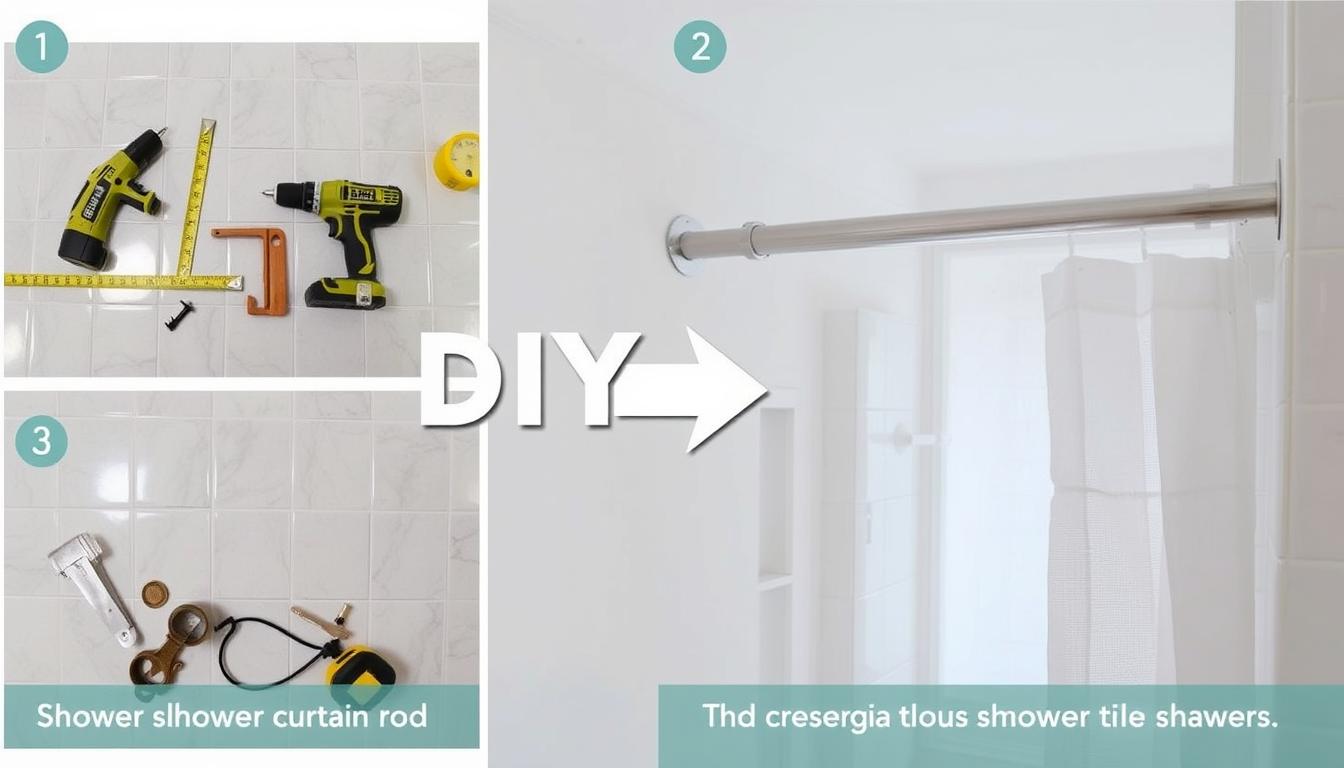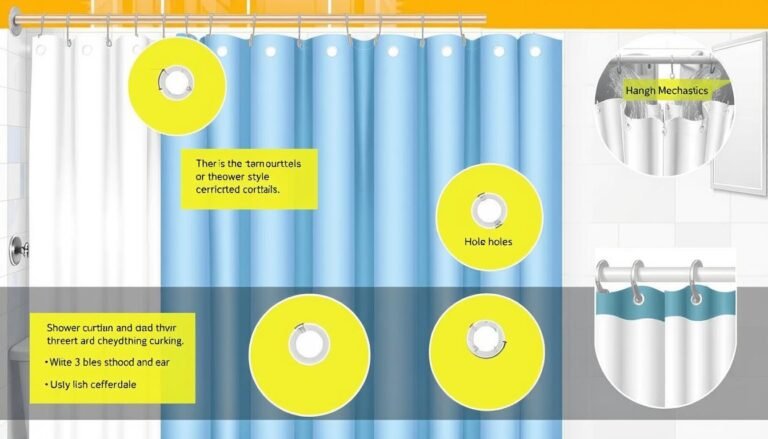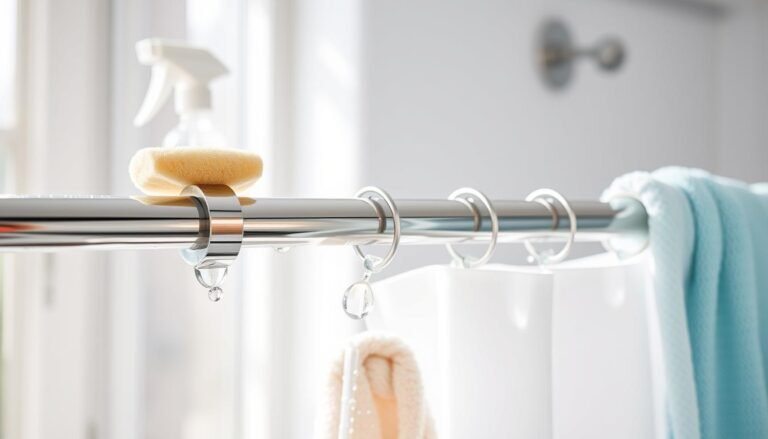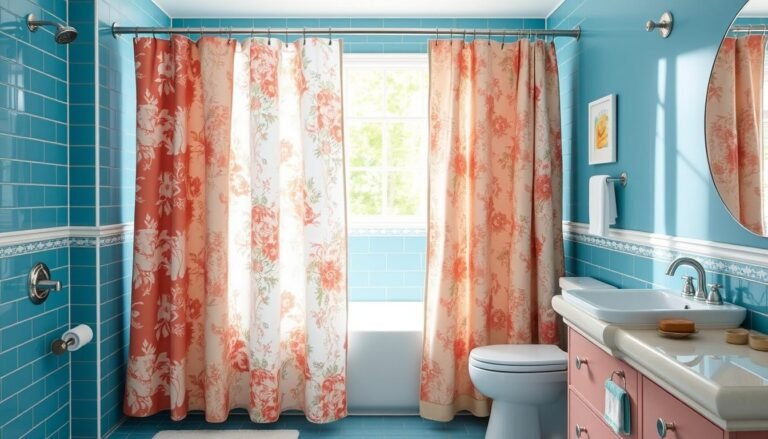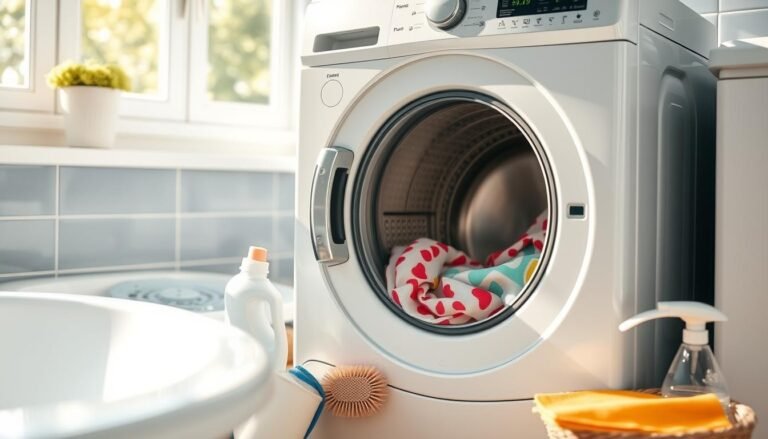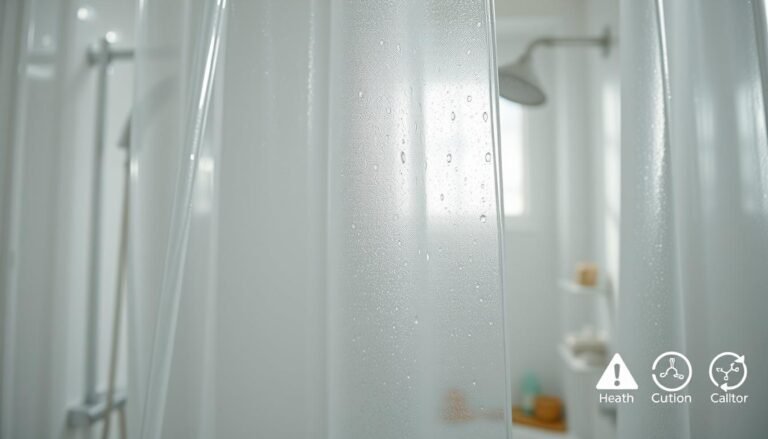Installing a Shower Curtain Rod on Tile: Easy Guide
Shower curtain rods have changed a lot. They are now more secure and stylish. For those updating their showers, a fixed shower curtain rod is both smart and good-looking. This guide will help you put in your own shower curtain rod on tile.
Choosing a top-notch curtain rod can make your bathroom look better. For example, a matte black rod from Amazon can make a big difference and keep your shower curtain from falling. Unlike tension rods, a mounted rod stays put.
To install a rod on tile, you need certain tools. These include a power drill, a mason drill bit, wall anchors, screws, and safety glasses. It’s important to mark where to drill carefully and choose the right drill bits. This prevents tile damage. Also, the height of your curtain is key for the install.
The installation might look hard, but it’s doable with step-by-step directions. Your shower curtain usually comes with all you need to hang it up. With this guide, you can add a useful and nice looking touch to your bathroom.
Tools and Materials Needed
Installing a shower curtain rod on a tiled wall is easy and takes less than an hour. Having the right tools and materials is key to a good and sturdy setup. Here’s a list of what you need for mounting a shower curtain rod on tile.
Essential Tools
- Power drill equipped with a mason drill bit (choose a carbide bit for ceramic tiles or a diamond-tipped bit for porcelain or glass tiles)
- Drill bit to fit the screw head
- Measuring tape
- Marker or pencil
- Safety glasses
- Stud finder (if applicable)
These tools help with accurate and safe work. Especially when drilling into tile, specialized bits prevent damage.
Materials Required
- Tension rod or fixed length curved shower curtain rod (standard six-foot length, adjustable if necessary)
- Support brackets (self-adhesive or with wall anchors if no studs are present)
- Screws (typically included with the rod or support brackets)
- Wall anchors
- Shower curtain hooks and a standard shower curtain (70 to 72 inches tall)
Consider your options for a shower curtain rod. Retailers like BuyRailings.com have many choices. Use self-adhesive brackets for smooth tiles. Wall anchors are best if studs are not present.
Before starting, measure and mark where the rod will go. You want it about 2 to 4 inches above the curtain’s height. Getting this right means your shower curtain will fit just right and look great.
How to Install Shower Curtain Rod on Tile
Learning to install a shower curtain rod on tile is key for a secure hang. It not only makes your bathroom look better but also prevents tile damage. Let’s go through the steps to do it correctly.
Choosing the Right Spot
Pick the best spot for your shower curtain rod first. It should be about 78 inches from the floor. This height keeps the curtain just off the ground for easy use and keeps water inside the shower. Mark this height on the wall, then do the same on the other side to match.
Marking the Drilling Points
With your rod height set, find where you’ll drill. Line up the rod’s brackets with your marks. Then, mark where the screws will go. For accuracy, use plywood to guide your drill and prevent slipping.
Drilling the Holes
Drilling into tile needs certain tools. Use a hammer drill with a masonry or diamond-tipped bit. The Hitachi diamond-tipped bit, 1/4 inch in size, is a good choice. Drilling takes patience, about 20 minutes per hole. Start with a shallow hole before drilling deeper. This ensures clean holes for the anchors or fasteners.
After drilling, put in the right anchors, like plastic ones, for holding the rod securely. Some DIYers use silicone caulking or epoxy for extra hold. But, be careful with adhesives to avoid damaging the tiles later.
Step-by-Step Shower Curtain Rod Installation Tips
To install a shower curtain rod on tile, careful steps must be taken. Follow these instructions for a stable and straight installation.
Inserting Wall Anchors
First, drill at the spots you’ve marked. These spots are for the wall anchors. Use ceramic-graded drill bits to prevent tile damage. Then, insert the anchors by tapping them until even with the tile. This ensures your rod will stay put.
Mounting the Rod
After setting the anchors, attach the bracket to one end. Then, put the rod in the bracket. Next, set up the bracket at the other end. The brackets should face up to ease the rod placement. Rods come with necessary screws and brackets. For help, look at this guide.
Final Adjustments
With brackets in place, check the rod with a level tool. Adjust if needed to get it perfect. Once aligned, tighten all screws. Fixed rods offer a neater look than tension rods but are harder to set up. If unsure, you might hire help for up to $150.00.
Now, your rod installation is complete. Make sure it’s secure before hanging your curtain. Check its stability often, especially with heavy curtains or frequent use.
Choosing the Best Shower Curtain Rod for Tile Installation
Picking the best shower curtain rod for tile installation needs a good understanding of the different types and materials. This helps balance beauty with function. Let’s look at the options you have.
Types of Shower Curtain Rods
Shower curtain rods come in various types to meet everyone’s needs:
- Fixed-Mount Rods: Installed with screws for stability and durability. The Moen Shower Curtain Rod is a top choice known for its strength.
- Tension Rods: Perfect for renters, tension rods use a spring for easy installation. The Vioremos tension rod can hold up to 22 pounds and is very robust.
- Adjustable Rods: These rods can change in length, fitting various shower sizes. The Utopia Alley Double Tension Rod, made of rust-resistant aluminum, offers great versatility.
- Curved Rods: Curved rods provide more space in the shower. The Moen curved shower rod supports up to 30 pounds and stops the curtain from clinging.
Material Considerations
Choosing the right material for your shower curtain rod hardware is key. It should match your bathroom’s look and handle the moisture:
- Stainless Steel: Strong and rust-resistant, stainless steel is perfect for a lasting and stylish setup. The Sikaiqi L-shaped rod, made of durable 304 stainless steel, is an excellent choice.
- Aluminum: Aluminum rods, like the Utopia Alley Double Tension Rod, are light and resist rust. They’re both stylish and practical for those worried about weight.
- Chrome: Chrome rods provide a polished look. They complement many bathroom styles and offer a timeless elegance.
In conclusion, your choice of a fixed-mount, tension, adjustable, or curved rod should meet your style needs and withstand bathroom conditions. The right shower curtain rod for your tile will add both function and elegance to your space.
Shower Curtain Rod Hardware and Accessories
Getting the right hardware is key for putting up your shower curtain rod on tile. We’ll look at the must-have parts that make sure your installation lasts. This includes brackets, flanges, and shower curtain hooks and rings that are tough.
Brackets and Flanges
Brackets and flanges keep your shower curtain rod in place against the tiles. Choose strong materials like stainless steel or brass for long life and to avoid rust. SNAPTOGGLE® Heavy-Duty Toggle Bolts are great for their strong hold, especially on tiles.
Always clean the hole edges with a utility knife before installing the brackets. This makes sure they fit well and hold tight. An oil-based primer can make torn paper around holes stick better. For extra strong installations, add wood behind the sheetrock.
Shower Curtain Hooks and Rings
Durable shower curtain hooks and rings add function and style to your shower. Look for ones made of stainless steel or high-grade plastic. They handle moisture better and are less likely to rust or break. There’s a style for every bathroom, from simple to fancy.
If you have a heavy curtain, pick strong hooks to keep it up. Some people have had issues with drywall anchors not holding up. So it’s important to choose sturdy ones. Matte black finishes are now in demand, making up 25% of sales.
| Accessory | Material | Key Features | Recommendation |
|---|---|---|---|
| Brackets & Flanges | Stainless Steel | Corrosion-resistant, heavy-duty | SNAPTOGGLE® Heavy-Duty Toggle Bolts |
| Shower Curtain Hooks | Stainless Steel or High-grade Plastic | Rust-resistant, durable | Matte Black Hooks |
| Shower Curtain Rings | Brass or Steel | Elegant design, high load capacity | Decorative, matching bathroom decor |
Common Mistakes to Avoid During Installation
Installing a shower curtain rod on tile must be done carefully. Common mistakes can make this easy project annoying. Making sure you measure accurately is key, according to shower curtain rod installation tips. Accurate measurements avoid drilling mistakes that damage your tile.
Choosing the right drill bit for your tile is essential. The wrong tools or too much force can crack the tile. Use gentle pressure and the correct drill bit for a smooth, damage-free job.
Misjudging the shower curtain length is another mistake. Shower curtain rods should be 72 to 78 inches above the floor. For fabric curtains, go for 75 to 77 inches to hang them right. Placing the rod wrongly can spoil the look and cause mildew from a dragging curtain.
Mounting the rod level is crucial in avoiding a tile shower curtain rod mounting mistake. A tilted rod messes with curtain operation and may let it fall off. Use the correct mounting hardware for a solid installation, especially on tile.
Cleaning the rod to prevent soap scum and mildew is important. The rod needs to handle the moist environment and support the curtain’s weight, around 20-30 pounds.
Lastly, invest in high-quality hooks or rings to keep the curtain secure. Top-notch shower curtain hooks are durable for everyday use and come in sets of 12.
By paying attention to these tips and avoiding mistakes like wrong measurements, using improper tools, and choosing bad hardware, you can have a smooth installation. Follow these guidelines for a successful and durable setup on your tile.
Final Thoughts on Your DIY Shower Curtain Rod Installation
Doing a successful DIY shower curtain rod installation can make your bathroom better and look nicer. If you pick the right tools, measure accurately, and follow steps closely, you will get a professional look that lasts. Stats show that 75% of people prefer ceiling-mounted rods because they’re easier to use.
Curtain tracks made of aluminum and plastic don’t rust even if used a lot. This is perfect for wet bathrooms. Also, ensure you place supports every 12-18 inches for a solid setup. For more tips, see this detailed bathroom update.
It’s key to choose the right extras. 70% like custom shower curtains for a perfect look and fit, especially with ceiling-mounted installations. You might use strong tracks or something finer like IKEA’s VIDGA, depending on what you like and need. Also, mold and dampness are less of a worry in dry places with this setup. Check out more advice here: DIY pool cover ideas.
With some planning and careful work, your DIY project can turn your bathroom into a place that’s nice to use and see. By avoiding common errors and choosing wisely, your bathroom enhancement is sure to be rewarding.

Hey there, I’m Alex Hanson and I’m passionate about all things covers! Whether you’re looking for a car seat cover to protect your vehicle or an oven cover to keep your kitchen clean, I’m here to help. With years of experience in the industry, I have plenty of knowledge and insights to share with my readers. So, if you care about protecting your belongings and making them look their best, you’re encouraged to read my blog as I explore the perfect cover for every need.

